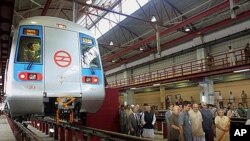The passenger rail system in India's capital has become the world’s first rail network to earn carbon credits from the United Nations for helping to reduce greenhouse gas emissions.
The so-called Delhi metro has become a popular mode of transport in its nine years of operation, a rare success story in a country where government projects are often criticized for being cheap or badly implemented.
Launched in 2002 in a city of about 14 million people, the system runs partly underground and partly on elevated tracks through some of the city's most crowded areas, carrying about two-million passengers a day.
The U.N. statement says the system has reduced emission of harmful gases and pollution levels in the city by 630,000 tons a year, mostly due to a regenerative braking process that helps save energy by nearly 30 percent.
Anumita Roy Choudhury at the Center for Science and Environment in New Delhi calls it a significant step in the global fight to reduce greenhouse gases.
"In the future, cities which are increasingly car centric will make the fight on global warming difficult unless we are able to make significant improvements in public transport systems," she said.
Environmentalists have long focused on the need to reduce the amount of carbon-emitting vehicles on roadways of India’s mega cities, and it is estimated that New Delhi's metro eliminates about 90,000 such trips every day.
The carbon credits afford the rail network $9.5 million annually over the next seven years, part of a U.N. scheme that incentivizes companies in developing countries to cut greenhouse gas emissions.
Only a handful of public transport systems globally have earned carbon credits. New Delhi's metro is the first rail network to qualify.
New Delhi Metro Earns Carbon Credits









